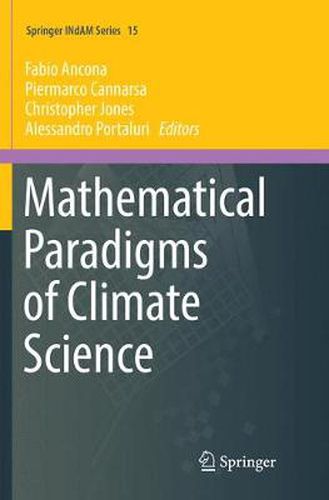Readings Newsletter
Become a Readings Member to make your shopping experience even easier.
Sign in or sign up for free!
You’re not far away from qualifying for FREE standard shipping within Australia
You’ve qualified for FREE standard shipping within Australia
The cart is loading…






This title is printed to order. This book may have been self-published. If so, we cannot guarantee the quality of the content. In the main most books will have gone through the editing process however some may not. We therefore suggest that you be aware of this before ordering this book. If in doubt check either the author or publisher’s details as we are unable to accept any returns unless they are faulty. Please contact us if you have any questions.
This book, featuring a truly interdisciplinary approach, provides an overview of cutting-edge mathematical theories and techniques that promise to play a central role in climate science. It brings together some of the most interesting overview lectures given by the invited speakers at an important workshop held in Rome in 2013 as a part of MPE2013 ( Mathematics of Planet Earth 2013 ). The aim of the workshop was to foster the interaction between climate scientists and mathematicians active in various fields linked to climate sciences, such as dynamical systems, partial differential equations, control theory, stochastic systems, and numerical analysis. Mathematics and statistics already play a central role in this area. Likewise, computer science must have a say in the efforts to simulate the Earth’s environment on the unprecedented scale of petabytes. In the context of such complexity, new mathematical tools are needed to organize and simplify the approach. The growing importance of data assimilation techniques for climate modeling is amply illustrated in this volume, which also identifies important future challenges.
$9.00 standard shipping within Australia
FREE standard shipping within Australia for orders over $100.00
Express & International shipping calculated at checkout
This title is printed to order. This book may have been self-published. If so, we cannot guarantee the quality of the content. In the main most books will have gone through the editing process however some may not. We therefore suggest that you be aware of this before ordering this book. If in doubt check either the author or publisher’s details as we are unable to accept any returns unless they are faulty. Please contact us if you have any questions.
This book, featuring a truly interdisciplinary approach, provides an overview of cutting-edge mathematical theories and techniques that promise to play a central role in climate science. It brings together some of the most interesting overview lectures given by the invited speakers at an important workshop held in Rome in 2013 as a part of MPE2013 ( Mathematics of Planet Earth 2013 ). The aim of the workshop was to foster the interaction between climate scientists and mathematicians active in various fields linked to climate sciences, such as dynamical systems, partial differential equations, control theory, stochastic systems, and numerical analysis. Mathematics and statistics already play a central role in this area. Likewise, computer science must have a say in the efforts to simulate the Earth’s environment on the unprecedented scale of petabytes. In the context of such complexity, new mathematical tools are needed to organize and simplify the approach. The growing importance of data assimilation techniques for climate modeling is amply illustrated in this volume, which also identifies important future challenges.